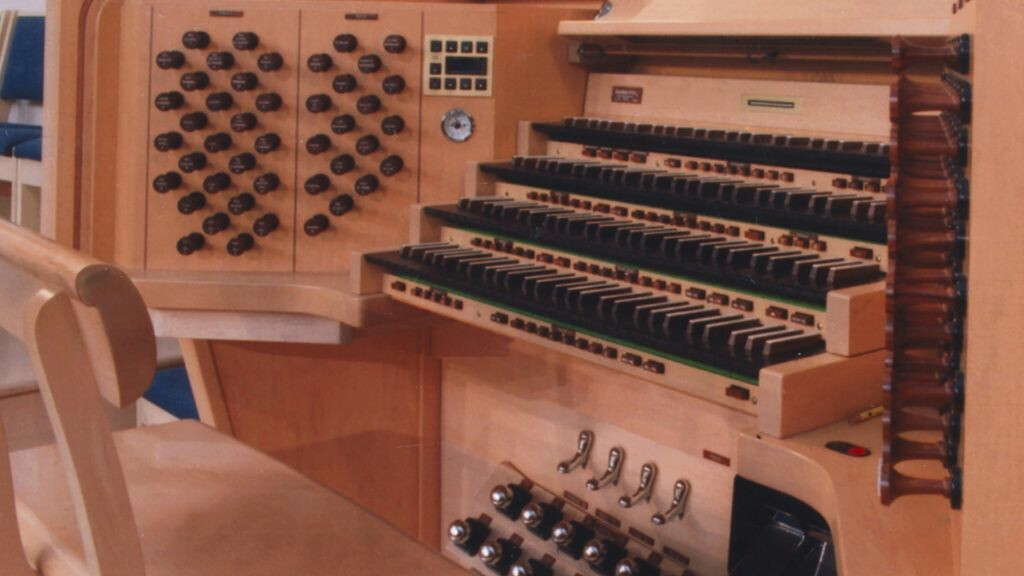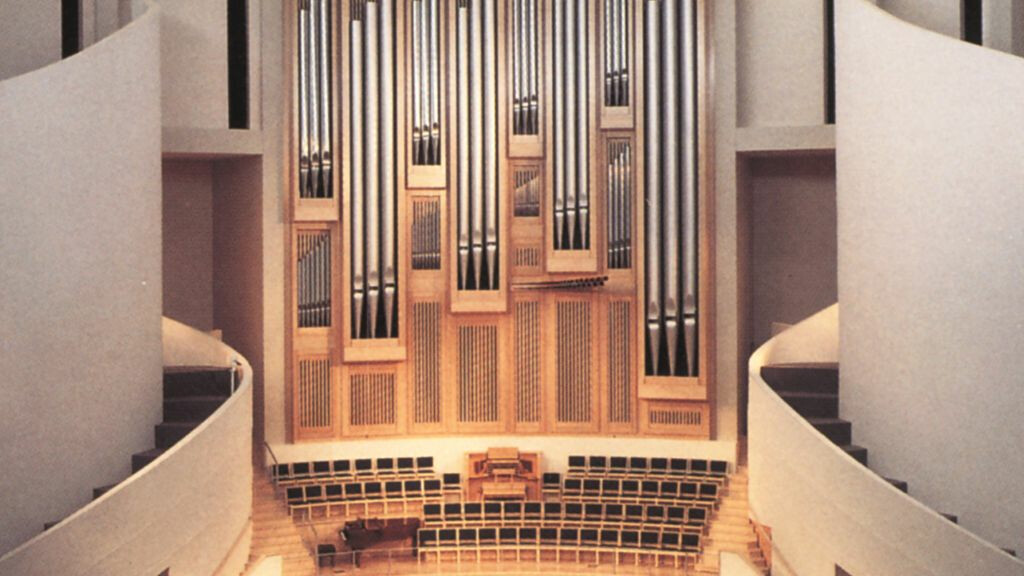Casavant Frères Limitée Opus 3700
About the Temple Organ
The Community of Christ Temple in Independence, Missouri, houses a magnificent organ built by Casavant Frères Limitée of St.-Hyacinthe, Quebec. Installed in early 1993, this remarkable instrument features:
- Four Manuals: Offering 60 stops and 102 ranks.
- 5,685 Pipes: Distributed across three levels in a 50-foot high, 40-foot wide, and 8-foot deep case.
- Diverse Materials: Pipes made from polished tin, lacquered zinc, spotted metal, and polished copper for the Trompette en chamade.
Design and Innovation
Designed by Jean-Louis Coignet, the organ blends classical French principles with modern technology. It uses mechanical action for the Grand Orgue, Positif, and Récit divisions, and electropneumatic action for the Résonance division, inspired by Brother Isnard’s 1772 design.


Tonal Foundation
The organ’s foundation is the 32’ Principal stop, with pipes ranging from nearly 40 feet to just ¼ inch. This creates a rich, enveloping sound that is both classical and romantic.
Spectacular Venue
The Temple’s sanctuary, accommodating 1,600 people, features a unique spiral design ascending to 195 feet, providing exceptional acoustics with four seconds of reverberation. This enhances the organ’s sound and the overall worship experience.
A Complement to the Auditorium Organ
The Casavant organ complements the Auditorium organ, making it one of North America’s most glorious instruments, as noted by former Kansas City Star music critic Scott Cantrell.
Specifications
- Manuals: 4
- Stops: 60
- Ranks: 102
- Pipes: 5,685
Visit the Awe-Inspiring Casavant Organ
Plan your visit to experience the awe-inspiring Casavant organ at the Community of Christ Temple.
Grand Orgue
Manual II (unenclosed, 85mm wp)
16’ Montre
8’ Montre
8’ Flûte à cheminée
4’ Prestant
4’ Flûte
2’ Doublette
V Cornet (8’) G8
IV-V Fourniture (1 1/3’)
IV Cymbale (2/3’)
16’ Bombarde (full length)
8’ Trompette
16’ Bombarde en chamade (Résonance)
8’ Trompette en chamade (Résonance)
Récit to Grand-Orgue 16’
Récit to Grand-Orgue
Récit to Grand-Orgue 4’
Positif to Grand-Orgue
Résonance to Grand-Orgue
Résonance
Manual IV (unenclosed, 120, 125, and 150mm wp)
32’ Montre*
32’ Bourdon*
16’ Principal*
16’ Flûte à cheminée*
8’ Diapason
8’ Flûte harmonique
8’ Flûte majeure
4’ Octave
3 1/5’ Grand tierce
II Harmonique (2 2/7’ + 1 7/9’)
III-VI Grand cornet (2 2/3’)
II-VI Grande fourniture (2 2/3’)
II-V Plein jeu harmonique (2’)
16’ Bombarde (full length)*
8’ Trompette*
4’ Clairon*
16’ Bombarde en chamade*
8’ Trompette en chamade* (200 mm wind pressure)
Tremblant
Positif
Manual I (enclosed, 85mm wp)
8’ Principal
8’ Voce umana (TC)
8’ Bourdon
4’ Prestant
4’ Flûte à fuseau
2 2/3’ Nazard
2’ Quarte de nazard
1 3/5’ Tierce
1 1/3’ Larigot
1 1/7’ Septième
8/9’ Neuvième
V Plein jeu (1’)
8’ Cromorne
Tremblant
Clochettes (10 bells)
16’ Bombarde en chamade (Résonance)
8’ Trompette en chamade (Résonance)
Récit to Positif
Résonance to Positif
Récit
Manual III (enclosed, 90mm wp, chorus reeds 125mm wp)
16’ Bourdon
8’ Principal
8’ Cor de nuit
8’ Viole de gambe
8’ Voix céleste (GG)
8’ Flûte douce
8’ Flûte céleste (TC)
4’ Octave
4’ Flûte octaviante
2’ Octavin
III Carillon (2 2/3’)
V-VI Plein jeu (2’)
16’ Basson (full length)
8’ Trompette harmonique
8’ Hautbois
8’ Voix humaine
4’ Clairon harmonique
Tremblant
Pédale
(unenclosed, 100 & 125mm wp; reeds 130 & 150mm wp)
32’ Montre*
32’ Flûte (12-note electronic extension)
32’ Bourdon (12-note electronic extension)
16’ Principal*
16’ Flûte
16’ Flûte à cheminée*
16’ Bourdon doux (Récit)
8’ Octavebasse
8’ Flûte
8’ Flûte à cheminée*
4’ Octave
4’ Flûte à cheminée*
III Théorbe (10 2/3’ + 6 2/5’ + 4 4/7’)
V Mixture (2 2/3’)
32’ Contre bombarde (full length)
16’ Trombone*
16’ Bombarde (Grand-Orgue)
16’ Basson (Récit)
8’ Trompette*
4’ Clairon*
8’ Trompette en chamade*
4’ Trompette en chamade*
Grand-Orgue to Pédale
Positif to Pédale
Récit to Pédale
Résonance to Pédale
* Stops in common in Résonance and Pédale
Design Details
Manual compass 61 notes
Pedal compass 32 notes
Mechanical or electric coupling available
Mechanical floating key action for Grand-Orgue, Positif, and Récit
Electric stop action and solid-state multilevel combination action with programmable Crescendo
Balanced expression pedals: Positif, Récit, Crescendo
Keyboards: ebony-covered naturals, rosewood sharps with bone caps
Pedalboard: maple naturals, rosewood sharps
Drawknobs, thumb pistons, and nameplates made of rosewood
Maple casework
Wind Pressures
Grand Orgue 85 mm
Récit 90 mm
Récit chorus reeds 125 mm
Positif 85 mm
Résonance 120, 125, and 150 mm
Pédale 100 and 125 mm
Pédale reeds 130 and 150 mm
Trompette en chamade 200 mm
